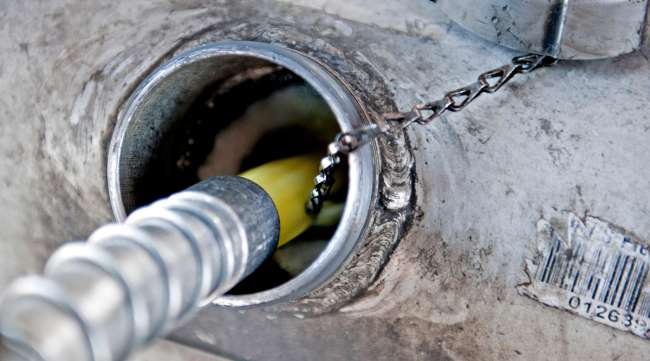Senior Reporter
Average Price of Diesel Continues to Linger in $2.40s

[Stay on top of transportation news: Get TTNews in your inbox.]
Diesel fell for the third consecutive week, by three-tenths of a cent to $2.424 a gallon, the Energy Information Administration reported Aug. 3.
With the decrease, the nationwide price of trucking’s primary fuel is 60.8 cents a gallon less than it was a year ago.
The cost of diesel decreased in seven of the 10 regions surveyed by EIA.
Gasoline showed an increase, but by just one-tenth of a cent, reaching an average of $2.176 a gallon. Gas is 51.2 cents cheaper than a year ago.

Transport Topics introduces its newest digital interview series, Newsmakers, aimed at helping leaders in trucking and freight transportation navigate turbulent times. Audience members will gain access to the industry's leading expert in their particular field and the thoughtful moderation of a Transport Topics journalist. Our second episode — "The Evolution of Electric Trucks" — featured Nikola founder and executive chairman Trevor Milton. To view the replay, complete this form.
All three regions where the diesel price increased were west of the Mississippi River. Prices rose one-tenth of a cent to $2.343 in the Rocky Mountain area. Diesel there is 62.2 cents less expensive than in August 2019.
The price increased by the same amount in the West Coast region to $2.955 from $2.954. Diesel is 65 cents less expensive there than a year ago.
The biggest increase was in the West Coast region, not including California, where the price jumped six-tenths of a cent to $2.592. Compared with last year, the price of diesel is 59 cents cheaper than a year ago.
The biggest drop came along the Gulf Coast, where diesel fell eight-tenths of a cent to $2.175 a gallon. Diesel in the region is 61.2 cents a gallon less expensive than it was in 2019. The area also boasts the lowest price nationwide because it is home to much of the country’s oil and gasoline production and a large share of the refining capacity.
The other regions of the country experienced declines in the price of diesel, ranging between one-tenth and three-tenths of a cent per gallon during the week, according to EIA.

Kloza
Oil Price Information Service founder and energy analyst Tom Kloza told Transport Topics that an abundance of diesel fuel is on the market. That is due, in part, to an estimated 500,000 school buses and 36,000 privately owned motorcoaches being parked because of delays returning to school and the shutdown of the over-the-road bus industry because of the COVID-19 pandemic.
Kloza says oil prices likely will continue to trade in a narrow range around $40 a barrel for the near future, which will keep prices stable or declining slightly.
“We’re looking at too much diesel, and it’s going to be a while before we work off the surplus that developed since February or so,” Kloza said. “You had a warm winter, you had an oil production war, and you had COVID, and it’s led to these ‘buy’ inventories for diesel.”

5G wireless networks promise greater bandwidth, faster speeds and improved reliability. But how long will the industry have to wait until this technology is ready for fleet operations? Host Seth Clevenger talks with Chris Wolfe of PowerFleet and John Binder of Trimble Transportation. Hear a snippet, above, and get the full program by going to RoadSigns.TTNews.com.
Much of the Northeast and parts of the Midwest use diesel for home heating, but because of the warmer winter, fuel demand was expected to be down 4%, according to EIA.
The weekly Baker Hughes rig count shows domestic and international oil production continues to fall. On July 31, the industrial service company said year-over-year production is down 73.6% with 251 rigs in service, or 691 fewer than at this time in 2019.
Baker Hughes ranks No. 73 on the Transport Topics Top 100 list of the largest private carriers in North America.
In Canada, the number of rigs operating increased by three to 45, compared with 137 a year ago. Still, the number of rigs operating is down 67.1% when compared with 2019.
Internationally, 24 rigs suspended operations last week. That leaves 781 in service versus 1,138 last July.
Meanwhile, according to Kloza, members of OPEC+ are set to relax production quotas that were enacted earlier this spring when world oil demand dropped by as much as 30% because of the COVID-19 pandemic. Those nations cut production by 9.6 million barrels a day, or about 10% of world oil demand. Now, they could begin restoring as much as 17% of production (1.6 million barrels a day) to the market.
Kloza said he’s not sure the world is ready to begin using that additional oil.
“We’ll see what August looks like,” he said. “We’ve kind of hit the wall in terms of demand recovery regarding gasoline. The question now is when we look at the last 120 days of the year, will we see the normal decline in gasoline demand, that happens as we get out of season, or see a normal increase in diesel demand as we do every fall?”
Want more news? Listen to today's daily briefing:
Subscribe: Apple Podcasts | Spotify | Amazon Alexa | Google Assistant | More




